Palm Universal Connector
 |
| Type | Communication, power supply, USB |
|---|
|
| Designer | Palm, Inc. |
|---|
| Superseded | Palm Serial |
|---|
| Superseded by | Palm Multi-Connector |
|---|
|
| Pin 1 | Signal - ground | GND |
|---|
| Pin 2 | Data + USB | USB_D+ |
|---|
| Pin 3 | Data - USB | USB_D- |
|---|
| Pin 4 | USB VBUS | VCC |
|---|
| Pin 5 | HotSync IRQ - +3.3 V push button | HOTSYNC |
|---|
| Pin 6 | not connected | N/C |
|---|
| Pin 7 | Signal - ground | GND |
|---|
| Pin 8 | Peripheral ID - USB Cradle : short
- Serial Cradle : 7.5 kΩ
- Mfg. Test Cradle : 20 kΩ
- USB Peripheral : 47 kΩ
- Serial Peripheral : 100 kΩ
- Modem : 220 kΩ
| ID |
|---|
| Pin 9 | power out +3.2 V, 100 mA max. | Vout |
|---|
| Pin 10 | RxD RS-232 in, GPS T | RxD |
|---|
| Pin 11 | TxD RS-232 out, GPS R | TxD |
|---|
| Pin 12 | Peripheral DETECT | DETECT |
|---|
| Pin 13 | CTS RS-232 in | CTS |
|---|
| Pin 14 | RTS RS-232 out | RTS |
|---|
| Pin 15 | DTR RS-232 out | DTR |
|---|
| Pin 16 | charge +5 V, 500–700 mA | CHARGE |
|---|
The Universal Connector was a standard port fitted to the bottom of many Palm PDA's from 2001 to 2004 and on units from other manufacturers that licensed Palm technology, including Garmin.
Out of the box, it is used to connect to the sync and charge cradle, allowing the Palm to connect to a desktop PC and receive battery power. A range of accessories were also available for the Universal Connector, including folding keyboards, external battery packs, wired and wireless modems, and many more.
The Universal Connector cradles were the first synchronization device that used USB to communicate with the host computer, in addition to the older serial port standard.
Some Palm devices manufactured between 2001 and 2004 did not use the Universal Connector. For instance, the Tungsten E had a mini-USB connector.
The Universal Connector was superseded by the Palm Multi-Connector for the final devices released by Palm, this standard added stereo audio output and mono microphone input.

A personal digital assistant (PDA), also known as a handheld PC, is a variety mobile device which functions as a personal information manager. PDAs have been mostly displaced by the widespread adoption of highly capable smartphones, in particular those based on iOS and Android, seeing a rapid decline in use after 2007.

Universal Serial Bus (USB) is an industry standard that establishes specifications for cables, connectors and protocols for connection, communication and power supply (interfacing) between computers, peripherals and other computers. A broad variety of USB hardware exists, including 14 different connector types, of which USB-C is the most recent and the only one not currently deprecated since the release of USB 3.2.

Palm OS was a mobile operating system initially developed by Palm, Inc., for personal digital assistants (PDAs) in 1996. Palm OS was designed for ease of use with a touchscreen-based graphical user interface. It is provided with a suite of basic applications for personal information management. Later versions of the OS have been extended to support smartphones. The software appeared on the company's line of Palm devices while several other licensees have manufactured devices powered by Palm OS.
ACCESS.bus, or A.b for short, is a peripheral-interconnect computer bus developed by Philips and DEC in the early 1990s, based on Philips' I²C system. It is similar in purpose to USB, in that it allows low-speed devices to be added or removed from a computer on the fly. While it was made available earlier than USB, it never became popular as USB gained in popularity.
The Zire Series was Palm, Inc's "consumer-grade" brand of Personal Digital Assistant.

The Tapwave Zodiac is a mobile entertainment console. Tapwave announced the system in May 2003 and began shipping in October of that same year. The Zodiac was designed to be a high-performance mobile entertainment system centered on video games, music, photos, and video for 18- to 34-year-old gamers and technology enthusiasts. By running an enhanced version of the Palm Operating System (5.2T), Zodiac also provided access to Palm's personal information management software and many other applications from the Palm developer community. The company was based in Mountain View, California.
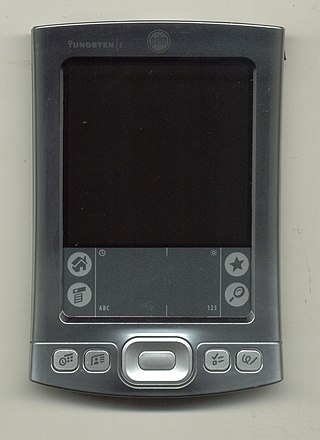
The Tungsten series was Palm, Inc.'s line of business-class Palm OS-based PDAs.

USB On-The-Go is a specification first used in late 2001 that allows USB devices, such as tablets or smartphones, to act as a host, allowing other USB devices, such as USB flash drives, digital cameras, mouse or keyboards, to be attached to them. Use of USB OTG allows those devices to switch back and forth between the roles of host and device. A mobile phone may read from removable media as the host device, but present itself as a USB Mass Storage Device when connected to a host computer.
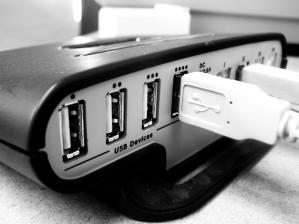
A USB hub is a device that expands a single Universal Serial Bus (USB) port into several so that there are more ports available to connect devices to a host system, similar to a power strip. All devices connected through a USB hub share the bandwidth available to that hub.
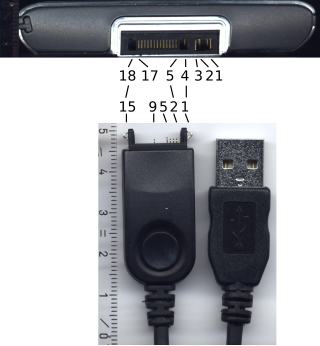
The Palm Multi-Connector is a power, audio and data interface connector designed by Palm, Inc.
Several Palm (PDA) enthusiasts have successfully documented internal and external handheld battery modifications to allow longer charge times for their handheld device. Rapidly advancing battery technology allows smaller and longer-lasting batteries to be placed into the space of the original batteries. Modifications of this type can be technically challenging and will almost certainly void any manufacturer warranty and have the potential to damage the modified device permanently.
The Palm m500 series of handheld personal digital assistants consisted of three devices: the Palm m500, Palm m505, and Palm m515. The series was a follow-up to the popular Palm V series with a similar, though slightly shorter, footprint and form factor.
HandEra was a manufacturer, software developer, and service contractor. HandEra's business previously revolved around Palm OS, and devices running Palm OS. The company's headquarters were in Des Moines, Iowa.

PDMI is an interconnection standard for portable media players. It has been developed by CEA as ANSI/CEA-2017-A standard Common Interconnection for Portable Media Players in February 2010. Chaired by David McLauchlan from Microsoft, the standard was developed with the input or support of over fifty consumer electronics companies worldwide.

A dock connector is a connector used to attach a mobile electronic device simultaneously to multiple external resources. The dock connector will typically carry a variety of signals and power, through a single connector, to simplify the process of docking the mobile device. A dock connector may be embedded in a mechanical fixture used to support or align the mobile device or may be at the end of a cable.

Universal charger or common charger refers to various projects to standardize the connectors of power supplies, particularly for battery-powered devices.
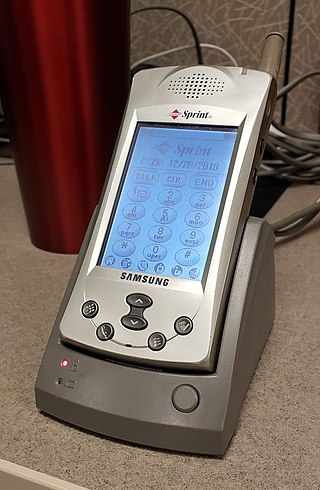
The Samsung SPH-i300 was an early Palm OS-based smartphone manufactured by Samsung. It was released around 2001. It was marketed in the United States for use on Sprint's mobile phone network. It was the first "PDA phone" in the US with a color screen.
The common external power supply was a specification for a universal charger, made by the European Commission for smartphones sold within the European Union. Although compliance was voluntary, a majority of the world's largest mobile phone manufacturers agreed to make their applicable mobile phones compatible with the specification. The specification effectively adopted micro-USB as a universal charger. The specification EN 62684:2010 was active from 2009 to 2014, and has since been withdrawn as obsolete.
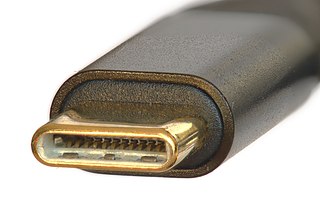
USB-C is a 24-pin USB connector system with a rotationally symmetrical connector. The designation C refers only to the connector's physical configuration or form factor and should not be confused with the connector's specific capabilities, which are designated by its transfer specifications. A notable feature of the USB-C connector is its rotational symmetry; a plug may be inserted into a receptacle in either orientation.
The initial versions of the USB standard specified connectors that were easy to use and that would have acceptable life spans; revisions of the standard added smaller connectors useful for compact portable devices. Higher-speed development of the USB standard gave rise to another family of connectors to permit additional data paths. All versions of USB specify cable properties; version 3.x cables include additional data paths. The USB standard included power supply to peripheral devices; modern versions of the standard extend the power delivery limits for battery charging and devices requiring up to 100 watts. USB has been selected as the standard charging format for many mobile phones, reducing the proliferation of proprietary chargers.













